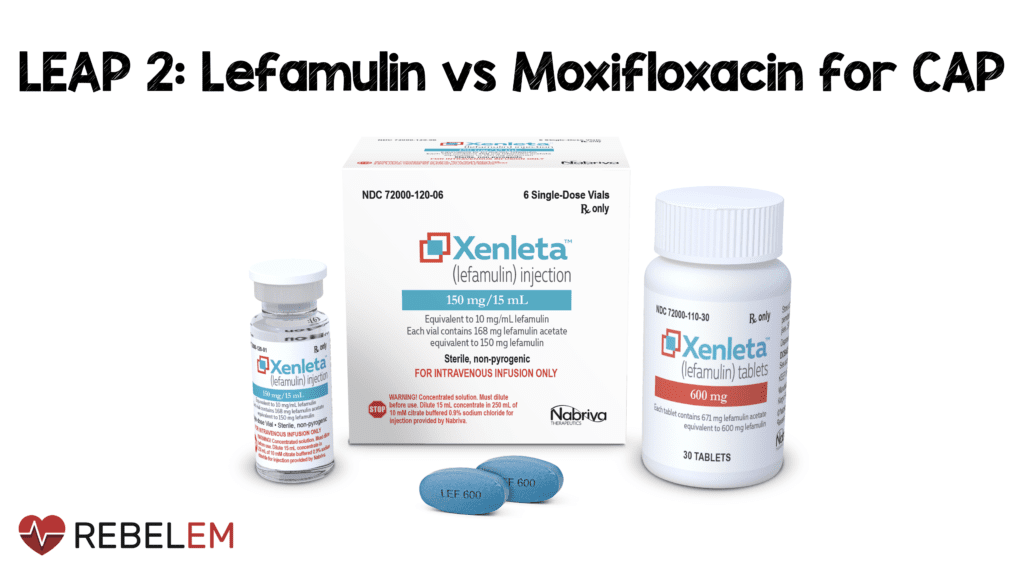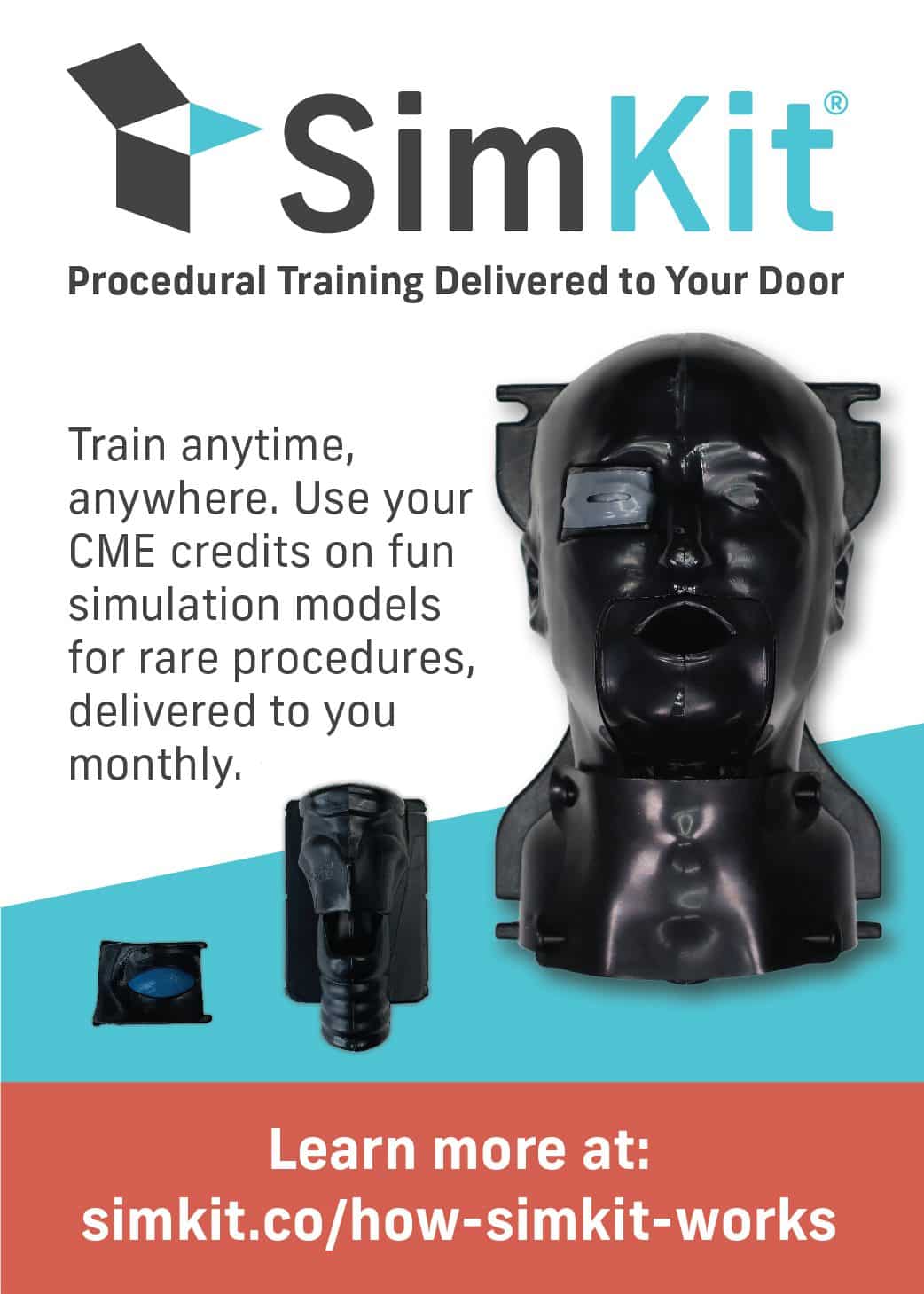
Lefamulin is the first pleuromutilin antibiotic approved for intravenous and oral use in humans. Both the intravenous and oral formulations were approved in August 2019 by the US Food and Drug Administration (FDA) to treat CAP. It is active against the most common CAP-causing pathogens, including bacteria resistant to other antimicrobial classes. Lefamulin Evaluation Against Pneumonia 1 (LEAP 1) [1] looked at IV Lefamulin vs IV Moxifloxacin in adult patients with moderate to severe CAP and demonstrated noninferiority in that trial. Given those results, LEAP 2 was performed to compare oral Lefamulin to oral Moxifloxacin in adult patients with moderate to severe CAP.
What They Did:
- Evaluate the efficacy and adverse events of a 5 day regimen of Lefamulin in patients with CAP
- Phase 3, double-blind, double-dummy, parallel-group non-inferiority randomized clinical trial
- Conducted at 99 sites in 19 countries
- Patients followed for up to 30d
- Patients randomized to:
- Oral Lefamulin (600mg PO q12hrs) x5d
- Oral Moxifloxacin (400mg q24hrs) x7d
Definitions:
- Intention to Treat (ITT) = All patients who were randomized
- Modified ITT = Patients who did not have an indeterminate clinical response, received study drug for a total duration of 48hrs or longer (unless patient died prior to 48hrs), did not receive a nonstudy antibacterial potentially effective against CAP pathogens (unless administered due to clinical failure), and had no additional factors that may have confounded efficacy assessment
- Microbiological ITT = All patients in the ITT population with 1 or more CAP pathogens detected at baseline
Outcomes:
- US FDA Primary:
- Early clinical response at 96hrs (within a 24hr window) after the first dose of either study drug (Defined as alive or, showing improvement in 2 or more of the 4 CAP symptoms, having no worsening of any CAP symptoms, and not receiving any nonstudy antibacterial drug for current CAP episode)
- European Medicines Agency Co-primary Endpoints Primary (US FDA Secondary):
- Investigator assessment of clinical response at test of cure (5 – 10 days after last dose of study drug) in the modified ITT population & in the clinically evaluable population
- Other Key Secondary:
- 28d all-cause mortality
Inclusion:
- Age ≥18 years
- Pneumonia Outcomes Research Team (PORT) risk class of II, III, or IV
- Radiographically documented pneumonia
- Acute illness (≤7d)
- 3 or more CAP symptoms (Dyspnea, new or increased cough, purulent sputum production, and chest pain)
- 2 or more vital sign abnormalities
Exclusion:
- Receipt of more than 1 dose of short acting (having a dosing interval more frequent than every 24hours) oral or intravenous antibacterial for CAP within 72hrs before randomization
- Hospitalization for 2 days or longer within 90 days
- Confirmed or suspected methicillin-resistant S aureus
- Being at risk for major cardiac events or dysfunction (known prolonged QT interval, clinically significant hypokalemia, clinically unstable cardiac disease, complete LBBB)
- Significant hepatic disease (known acute hepatitis, history of cirrhosis, manifestation of ESLD)
Results:
- 738 patients randomized
- PORT risk class of II, III, or IV = 48.8% of study population
- Early Clinical Response Rates:
- Lefamulin: 90.8%
- Moxifloxacin: 90.8%
- 95% CI 04.4% to Infinity
- Investigator Assessment of Clinical Response Success:
- Lefamulin: 87.5%
- Moxifloxacin: 89.1%
- Investigator Assessment of Clinical Response at Test of Cure in Clinically Evaluable Population:
- Lefamulin: 89.7%
- Moxifloxacin 93.6%
- Early Clinical Response Rates for Multidrug-Resistant S pneumoniae:
- Lefamulin: 100% (8/8)
- Moxifloxacin: 83.3% (10/12)
- CAVEAT: More pts in lefamulin group had a greater number of PORT risk class severity scores of II or IV (69.2%) vs the moxifloxacin group 36.8%
- Early Clinical Response Rates for Penicillin-Susceptible S pneumoniae:
- Lefamulin: 76.9% (20/26)
- Moxifloxacin 94.7% (36/38)
- Treatment-Emergent Adverse Events:
- Lefamulin: 32.6%
- Moxifloxacin: 25.0%
- Most adverse events were mild to moderate in severity
- Most Common Treatment-Emergent Adverse Events
- Diarrhea:
- Lefamulin: 12.2%
- Moxifloxacin: 1.1%
- Nausea:
- Lefamulin: 5.2%
- Moxifloxacin: 1.9%
- Diarrhea:
Strengths:
- Randomized clinical trial
- Important study investigating use of a new class of antibiotics for human use
- Used an intention-to-treat analysis which includes all patients randomized regardless of crossover or protocol violations which mimics reality of everyday practice
- 707 (95.8%) completion rate of trial (i.e. little loss to follow up)
- Double blind study: Patients in the lefamulin group received an oral moxifloxacin placebo every 24hrs for 7 days and patients in the moxifloxacin group received an oral lefamulin placebo every 12 hours for 5 days
- Demographic and baseline characteristics balanced between groups
- Mean duration of exposure to study drug was 5.0 days for lefamulin and 6.7 days for moxifloxacin, which reflects the intended duration of active treatment for each drug
Limitations:
- Subjective primary outcomes
- Non-inferiority margin of 10% was based on analysis of observational studies comparing no treatment vs antibacterial therapy. Would have been better if they compared another
- Study not designed for statistical inference in subpopulations and these results are only hypothesis generating
- Extensive list of exclusion criteria will limit the generalizability of these results to subpopulations with major diseases
- Patients with methicillin-resistant S aureus were excluded
- The overall recovery of resistant pathogens was low making it difficult to say if Lefamulin is the best option in these patients
Discussion:
- Noninferiority margin set at 10% for early clinical response and investigator assessment of clinical response.
- Imagine these three hypotheses comparing two antibiotics:
- New antibiotic at least as good as old antibiotic (Non-inferiority)
- New antibiotic better than old antibiotic (Superiority)
- New antibiotic equivalent to the old antibiotic (Equivalent)
- Of the three statements, the one with the highest success rate is non-inferiority studies, which is why it is a common method applied for drug companies trying to sell new therapies…more likely to be successful (for more on this checkout our post on Omadacycline)
- ≈50% of patients were in PORT risk class II, ≈38% in the PORT risk class III, and 11% in PORT risk class IV
- Most common isolated pathogens were Strep pneumoniae (63.7% and H influenzae 26.6%)
- Resistance rates to moxifloxacin were low in this study (≈25%)
- The cost per day of IV Lefamulin is $205/day and $275/day for oral treatment
- The cost per day of IV moxifloxacin is $70/day and $10/day for oral treatment
Author Conclusion: “Among patients with CABP, 5-day oral lefamulin was noninferior to 7-day oral moxifloxacin with respect to early clinical response at 96 hours after first dose.”
Clinical Take Home Point: Both Lefamulin and Moxifloxacin had a high cure rate in the ITT population with CAP, however given the cost of Lefamulin and greater GI side effects compared to Moxifloxacin, unless there is known bacterial resistance, or a good reason to use this antibiotic, the antibiotic to choose is still Moxifloxacin or a penicillin + macrolide for CAP.
References:
- File TM Jr et al. Efficacy and Safety of Intravenous-to-Oral Lefamulin, a Pleuromutilin Antibiotic, for the Treatment of Community-Acquired Bacterial Pneumonia: The Phase III Lefamulin Evaluation Against Pneumonia (LEAP 1) Trial. Clin Infect Dis 2019. PMID: 30722059
- Alexander E et al. Oral Lefamulin vs Moxifloxacin for Early Clinical Response Among Adults With Community-Acquired Bacterial Pneumonia: the LEAP 2 Randomized Clinical Trial. JAMA 2019. PMID: 31560372
For More Thoughts on This Topic Checkout:
- The Bottom Line: LEAP2 – New Antibiotics!
Post Peer Reviewed By: Anand Swaminathan, MD (Twitter: @EMSwami)




